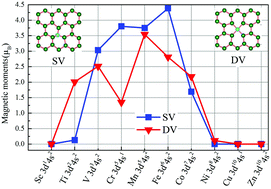Tuning electronic structures of the stanene monolayer via defects and transition-metal-embedding: spin–orbit coupling
Abstract
The electronic structures and magnetism of defect- and transition metal (TM)-embedded stanene monolayers are investigated by using first-principles methods. Single vacancy (SV) and double vacancy (DV) cannot induce magnetism, while embedding a TM can effectively tune the magnetic moments of the stanene monolayer. Moreover, the results show that all 3d TM-embedded stanene monolayers are stable. The TM-embedded SV is easier to form than DV. For TM-embedded SV systems, the Ti-embedded case presents half-metallic properties. However, for TM-embedded DV systems, the Ti-embedded system is a magnetic semiconductor and spin–orbit coupling (SOC) effects remarkably increase its band gap. Interestingly, the SOC interaction induces electronic phase transition from the semiconductor to the half-metal (metal) for Ni (Zn)-embedded DV systems. These results provide a promising route to design stanene-based spintronics devices.


 Please wait while we load your content...
Please wait while we load your content...